Pollution flowing faster than facts in EPA spill
http://www.cnn.com/2015/08/10/us/colorado-epa-mine-river-spill/
The mustard hue of the Animas River in Colorado -- the most visible effect of a mistake by the Environmental Protection Agency that dumped millions of gallons of pollutants into the water -- is striking.
Just a glance at a photo of the orange-yellowish slush is enough to know that something seems wrong. Scientists will have to say just how wrong, and possibly dangerous, the contamination is, though five days after the spill answers are few.
Just how polluted is the river? Is drinking water in peril? Are businesses dependent on the river out of luck?
One question that has been answered is the size of the spill: more than triple than originally estimated. The U.S. Geological Survey reported the size of the spill to be more than 3 million gallons, compared with the initial EPA estimate of 1 million gallons.
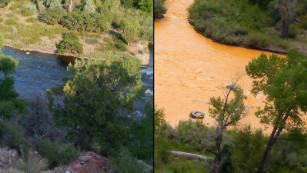
Tom Bartles, who lives in Durango, Colorado shared these photos of the Animas River from the viewpoint of his backyard before and after the spill.
The EPA, which caused the accidental release of the contaminants Wednesday, said it continues to monitor the river.
"Collection, transportation and lab analysis of metals in water is complex and time-consuming," the agency said in a statement.
Cities in New Mexico are also at risk as the pollution flows from the Animas River into the San Juan River.
A flyover with a specialized aircraft showed that the conditions on the Animas and San Juan rivers between Durango, Colorado, and Farmington, New Mexico, have improved, the EPA said.
According to the EPA, the spill occurred when one of its teams was using heavy equipment to enter the Gold King Mine, a suspended mine near Durango. Instead of entering the mine and beginning the process of pumping and treating the contaminated water inside as planned, the team accidentally caused it to flow into the nearby Animas River.
'This is a really devastating spill'
Officials said they believe the spill carried heavy metals -- mainly iron, zinc and copper -- from the mine into a creek that feeds into the Animas.
Wednesday's spill caused a spike in concentrations of total and dissolved metals in the water, the EPA said.
According to sampling done by the EPA on various points along the Animas River Wednesday and Thursday last week, levels of lead, arsenic, beryllium, cadmium and mercury were extremely high compared with acceptable levels set by the agency, which are technically called "maximum contaminant levels" or "action levels for treatment."
One of the samples of mercury was nearly 10 times higher than the EPA acceptable levels. Samples of beryllium and cadmium were 33 times higher, and one of the arsenic levels was more than 800 times higher.
Exposure to high levels of these metals can cause an array of health problems from cancer to kidney disease to developmental problems in children.
"This is a real mess," said Max Costa, chair of the department of environmental medicine at New York University School of Medicine. "These levels are shocking."
According to the EPA, levels "began to return toward pre-event conditions" by Thursday. The agency has collected water samples from nine locations along the San Juan River where there are water intake plants.
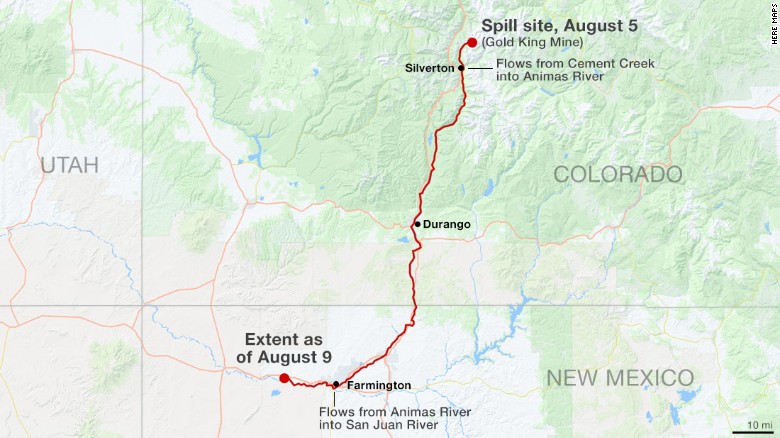
River spill map
"This is a really devastating spill," said Kim Stevens, director of the advocacy group Environment Colorado. "We've been hearing from rafting companies and other businesses that rely on the river that if they can't get clients out on the river in the next couple of days, they may have to shut down their doors."
The rivers' ecosystems are also at risk, she said.
"The fish population is especially very sensitive to water contamination, and we really won't be able to see what the impacts are until all of the pollution has run its course. Time will tell what the true impacts are," she said.
The EPA and the New Mexico Environment Department said they will test private domestic wells near the Animas to identify metals of concern from the spill.
Tests on public drinking water systems are conducted separately by the state environment department, the agencies said.
'They're not going to get away with this'
Some people are upset at the EPA -- both for the initial spill and its response.
Navajo Nation President Russell Begaye has announced he intends to take legal action against the federal agency.
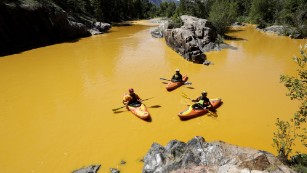
11 photos: EPA spill turns Colorado river orange
740.jpg

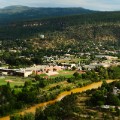
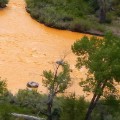
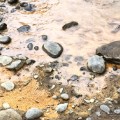
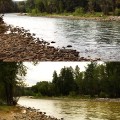
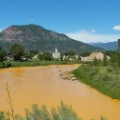


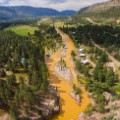
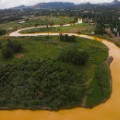
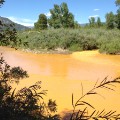
"They are not going to get away with this," Begaye said in a statement. "The EPA was right in the middle of the disaster and we intend to make sure the Navajo Nation recovers every dollar it spends cleaning up this mess and every dollar it loses as a result of injuries to our precious Navajo natural resources."
In a statement from NMED, state engineer Tom Blaine said that the EPA took no action to alert residents of New Mexico to the potential danger, and did not notify the state directly.
Colorado Gov. John Hickenlooper, meanwhile, declared a state-of-disaster emergency on Monday, a move that allocates $500,000 from the state's disaster emergency fund to pay for assessments and the response.
"Our priority remains to ensure public safety and minimize environmental impacts," the governor said.
"By declaring a disaster emergency, we are able to better support impacted businesses and communities with state resources. We will work closely with the EPA to continue to measure water quality as it returns to normal, but also to work together to assess other mines throughout the state to make sure this doesn't happen again," he said.
http://www.cnn.com/2015/08/10/us/colorado-epa-mine-river-spill/
The mustard hue of the Animas River in Colorado -- the most visible effect of a mistake by the Environmental Protection Agency that dumped millions of gallons of pollutants into the water -- is striking.
Just a glance at a photo of the orange-yellowish slush is enough to know that something seems wrong. Scientists will have to say just how wrong, and possibly dangerous, the contamination is, though five days after the spill answers are few.
Just how polluted is the river? Is drinking water in peril? Are businesses dependent on the river out of luck?
One question that has been answered is the size of the spill: more than triple than originally estimated. The U.S. Geological Survey reported the size of the spill to be more than 3 million gallons, compared with the initial EPA estimate of 1 million gallons.

Tom Bartles, who lives in Durango, Colorado shared these photos of the Animas River from the viewpoint of his backyard before and after the spill.
The EPA, which caused the accidental release of the contaminants Wednesday, said it continues to monitor the river.
"Collection, transportation and lab analysis of metals in water is complex and time-consuming," the agency said in a statement.
Cities in New Mexico are also at risk as the pollution flows from the Animas River into the San Juan River.
A flyover with a specialized aircraft showed that the conditions on the Animas and San Juan rivers between Durango, Colorado, and Farmington, New Mexico, have improved, the EPA said.
According to the EPA, the spill occurred when one of its teams was using heavy equipment to enter the Gold King Mine, a suspended mine near Durango. Instead of entering the mine and beginning the process of pumping and treating the contaminated water inside as planned, the team accidentally caused it to flow into the nearby Animas River.
'This is a really devastating spill'
Officials said they believe the spill carried heavy metals -- mainly iron, zinc and copper -- from the mine into a creek that feeds into the Animas.
Wednesday's spill caused a spike in concentrations of total and dissolved metals in the water, the EPA said.
According to sampling done by the EPA on various points along the Animas River Wednesday and Thursday last week, levels of lead, arsenic, beryllium, cadmium and mercury were extremely high compared with acceptable levels set by the agency, which are technically called "maximum contaminant levels" or "action levels for treatment."
One of the samples of mercury was nearly 10 times higher than the EPA acceptable levels. Samples of beryllium and cadmium were 33 times higher, and one of the arsenic levels was more than 800 times higher.
Exposure to high levels of these metals can cause an array of health problems from cancer to kidney disease to developmental problems in children.
"This is a real mess," said Max Costa, chair of the department of environmental medicine at New York University School of Medicine. "These levels are shocking."
According to the EPA, levels "began to return toward pre-event conditions" by Thursday. The agency has collected water samples from nine locations along the San Juan River where there are water intake plants.

River spill map
"This is a really devastating spill," said Kim Stevens, director of the advocacy group Environment Colorado. "We've been hearing from rafting companies and other businesses that rely on the river that if they can't get clients out on the river in the next couple of days, they may have to shut down their doors."
The rivers' ecosystems are also at risk, she said.
"The fish population is especially very sensitive to water contamination, and we really won't be able to see what the impacts are until all of the pollution has run its course. Time will tell what the true impacts are," she said.
The EPA and the New Mexico Environment Department said they will test private domestic wells near the Animas to identify metals of concern from the spill.
Tests on public drinking water systems are conducted separately by the state environment department, the agencies said.
'They're not going to get away with this'
Some people are upset at the EPA -- both for the initial spill and its response.
Navajo Nation President Russell Begaye has announced he intends to take legal action against the federal agency.

11 photos: EPA spill turns Colorado river orange
740.jpg











"They are not going to get away with this," Begaye said in a statement. "The EPA was right in the middle of the disaster and we intend to make sure the Navajo Nation recovers every dollar it spends cleaning up this mess and every dollar it loses as a result of injuries to our precious Navajo natural resources."
In a statement from NMED, state engineer Tom Blaine said that the EPA took no action to alert residents of New Mexico to the potential danger, and did not notify the state directly.
Colorado Gov. John Hickenlooper, meanwhile, declared a state-of-disaster emergency on Monday, a move that allocates $500,000 from the state's disaster emergency fund to pay for assessments and the response.
"Our priority remains to ensure public safety and minimize environmental impacts," the governor said.
"By declaring a disaster emergency, we are able to better support impacted businesses and communities with state resources. We will work closely with the EPA to continue to measure water quality as it returns to normal, but also to work together to assess other mines throughout the state to make sure this doesn't happen again," he said.
